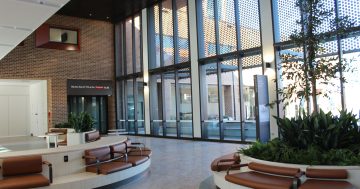
Only 46 per cent of patients were seen within the designated timeframes in ACT emergency departments. Photo: Region Media.
ACT Health Minister Rachel Stephen-Smith has reassured Canberrans they will be given the care they need despite figures from the Australian Institute of Health and Welfare showing wait times for Canberrans presenting to emergency departments are the worst in Australia.
Data released today (11 December) shows there were 149,273 presentations to emergency departments in Canberra in the 2018-19 financial year. This figure has increased by one per cent from 2017-18 when there were 147,778 people who were treated at an emergency department.
On arrival at an emergency department, patients are assigned a triage category of resuscitation (should be seen immediately), emergency (within 10 minutes), urgent (within 30 minutes), semi-urgent (within 60 minutes) or non-urgent (within two hours).
The ACT recorded the lowest rate of emergency department patients being seen on time in Australia.
Nationally, 71 per cent of patients were seen on time. In the ACT, only 46 per cent of patients were seen within the designated timeframes.
ACT Health Minister Rachel Stephen-Smith said waiting times continue to be a challenge for the ACT’s hospitals.
“We have seen significant population growth over recent years, resulting in an increased demand for health services,” Ms Stephen-Smith told Region Media.
“We know there is more work to be done to ensure Canberrans have access to timely and professional healthcare when it is needed most.
“We need to continue investing in our healthcare staff, infrastructure and community-based programs to ensure we can meet the changing demands of our growing city and ageing population.”
The minister reassured Canberrans that if they present to an emergency department needing urgent care, they will be given the care they need.
Ms Stephen-Smith pointed to a number of initiatives such as the $6.7 million expansion of the emergency department and the number of theatres at Calvary Public Hospital. The expansion will deliver 22 additional treatment spaces and will see more than 40 health staff joining the ED team in the next two years.
“The expansion is on track to be completed by March 2020 and will provide a 50 per cent increase to Calvary’s ED treatment capacity and an additional 20 per cent across the territory,” Ms Stephen-Smith said.
Additional investments will be made to the walk-in centres at Dickson and Weston Creek. The Weston Creek walk-in centre will open this month while the Dickson walk-in centre will open sometime next year.
“Over the next five years, we will invest almost $1 billion in new and improved healthcare infrastructure right across Canberra,” Ms Stephen-Smith said.
“This includes the new state-of-the-art emergency, critical and surgical healthcare facility at the Canberra Hospital, delivering a bigger hospital with more operating rooms, emergency treatment spaces and intensive care beds.
“Whilst we are in the planning stages of the SPIRE Project, we will continue to fund our health services appropriately, investing in additional healthcare staff, community-based programs and preventive health initiatives.”

The Canberra Hospital’s Emergency Department. There were 149,273 presentations to emergency departments in Canberra in the 2018-19 financial year. Photo: ACT Health.
The latest emergency department data shows that there were 8.4 million presentations to Australian public hospital emergency departments in 2018–19, an average of about 23,000 presentations per day, up 4.2 per cent on 2017–18.
“In 2018-19, 71 per cent of patients were seen on time for their urgency category, down from 74 per cent in 2014-15. All patients in the most urgent category, ‘resuscitation’, were seen immediately,” AIHW spokesperson Dr Adrian Webster said.
“Three-quarters of patients in the second-most urgent category – ‘emergency’ – were seen within the required 10 minutes.”
In Canberra during 2018-19, 77,316 females presented to emergency departments, compared with 71,903 males.
The age bracket with the highest number of people needing treatment at an emergency department were those aged 15-24 and 25-34 years.
The majority of treatments were for fractures, burns, toxic effects of medicinal and non-medicinal substances, and other complications.
Sixty per cent of emergency department patients went home after being treated, while almost one-third of patients (31 per cent) were admitted to hospital for further care.




















